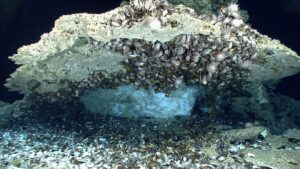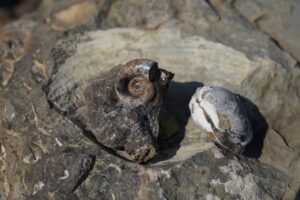Arctic Mesozoic methane seep communities
Arctic Mesozoic methane seep communities
Professor Crispin Little, Professor Fiona Gill, Dr Stephen Hunter (all School of Earth and Environment, University of Leeds); Dr Steffen Kiel (Department of Palaeobiology, Swedish Museum of Natural History)
Contact email: earctsl@leeds.ac.uk
Introduction:
Methane seeps are discrete sites where fluids rich in methane flow onto the seafloor. Only discovered in 1984, they are now known in all the World’s oceans. Methane seeps support extraordinary biological communities (Figure 1), the workings of which have radically altered our view of the life in the deep sea. This is because the primary energy source for these ecosystems comes not directly from the sun, but instead from sub-surface chemical compounds, particularly methane and hydrogen sulphide. The animals that dominate modern seep communities are dependent nutritionally on symbiotic bacteria which directly use methane and hydrogen sulphide for their energy requirements. Much is still unknown about modern seep communities, in particular, how seep animals disperse between seep sites, which are patchily distributed. The few biogeographic studies show that while many seep species are restricted to individual seep sites, at higher taxonomic level the communities are largely similar throughout the World’s oceans.

Figure 1. Seafloor methane seep from the Northwestern Atlantic, showing, at centre, white methane hydrates surrounded by mussels attached to seep carbonate and on the sediment. Image from NOAA Ocean Exploration.
This appears not to have been case in the Jurassic and Cretaceous eras. Preliminary evidence from high latitude methane seeps from Northeastern Greenland, Spitsbergen, Novaya Zemlya and the Canadian Arctic suggests that there was a seep fauna in the Arctic area distinct from that of contemporary lower latitude seeps, and thus there was strong biogeographic control on seep communities for at least 90 million years in the Mesozoic. Potential explanations may be related to the isolation of the Arctic area seeps in the Boreal Ocean (equivalent to today’s Arctic Ocean) in the Jurassic and Cretaceous, and/or contemporary differences in the environment, such as latitudinal seawater temperatures, or water depth. Latitudinal temperature controls were probably much weaker in the Jurassic and Cretaceous than today, because this was a greenhouse period in Earth History. However, it is also becoming apparent that during the Mesozoic there were also cold episodes, when limited polar ice may have been present. It is possible that during these periods relative sea levels would have been lower, so there may have been fewer connections between ocean basins, and thus less opportunity for exchange of animal larvae between contemporary high and low latitude seeps.

Figure 2. Middle Jurassic to Cretaceous timescale showing seep sites from Arctic areas (red) and contemporary non-Arctic sites (yellow), global and polar climate, and Boreal faunal endemism. Arctic area seep site abbreviations: NZ = Novaya Zemyla; S = Spitsbergen; Kh = Kuhnpasset (Northeastern Greenland); PPI = Prince Patrick Island; ERI = Ellef Ringnes Island (both Canadian Arctic); Le = Leitch Bjerg (Northeastern Greenland).
Aims and methodology:
The objective of this project is test whether there was a taxonomically distinct methane seep fauna in the high northern latitudes over 90 million years between the Upper Jurassic and the Upper Cretaceous, with a different evolutionary history to contemporary low latitude seep communities. The methodology will be to compare the Arctic area Mesozoic seep fossil assemblages for five Upper Jurassic to Upper Cretaceous time slices (Oxfordian-Kimmeridgian, latest Tithonian to Valanginian, Barremian, Albian and Campanian) where there are both Arctic area seeps and lower latitude examples. The data for this comparison consists of substantial, but previously poorly studied collections of invertebrate fossils from Northeastern Greenland, from Novaya Zemlya and the Canadian Arctic, which are currently housed in the Palaeontology Laboratories of the School of Earth Sciences, University of Leeds. These fossils comprise mainly bivalves, with smaller numbers of gastropods, ammonites (Figure 3), and then other invertebrates (e.g. scaphopods, serpulids, corals). These fossils will be described taxonomically (which will first involve a substantial amount of preparation work), and then integrated into palaeoecological groupings for each location. These data will then be integrated with similar published information from the Spitsbergen seeps into a comprehensive database of Mesozoic seep fossils from the five Upper Jurassic to Upper Cretaceous time slices. This database will then be interrogated using multivariate statistical methods and network analysis to investigate the main palaeobiogeographic aim of the project. Subsequently, these data will be combined with pre-existing palaeoclimate and ocean circulation models developed in the School of Earth Sciences for these Arctic area Mesozoic seeps to explore to what extent the contemporary palaeogeographic conditions might have controlled the distribution of Arctic area seep communities during the Jurassic and Cretaceous.

Figure 3. Ammonite and lucinid bivalve from a seep limestone, Kuhnpasset, Northeastern Greenland.
Training:
The project is interdisciplinary and the student will work within the Earth Surface Science Institute (ESSI) under the supervision of Professors Crispin Little and Fiona Gill (macrofossil palaeontology), Dr Steffen Kiel (numerical palaeobiology), and Dr Stephen Hunter (palaeoceanographic modelling). Through their expertise the student will receive project specific training in fossil preparation techniques, taxonomy (particularly of the molluscs), palaeoecological and palaeoenvironmental analysis, multivariate statistics, network analysis, and integration of palaeobiogeographic data with palaeoclimate and ocean circulation model data, specifically to help interpret larval dispersal using existing Lagrangian particle transport modelling conducted using data from the state-of-the-art MITgcm ocean model. The student will also be part of a wider network of highly active palaeontological and modelling researchers with ESSI, and will receive generic training provided through the Doctoral Training Network.
References
- https://en.wikipedia.org/wiki/Cold_seep.
- Hryniewicz, K., Nakrem, H.A., Hammer, Ø., Little, C.T.S., Kaim, A., Sandy, M.R. and Hurum, J.A. 2015. The palaeoecology of latest Jurassic-earliest Cretaceous hydrocarbon seep carbonates from Spitsbergen, Svalbard. Lethaia, v. 48, p. 353-374.
- Williscroft, K., Grasby, S.E., Beauchamp, B., Little, C.T.S., Dewing, K., Birgel, D. Poulton, T and Hryniewicz, K. 2017. Extensive Cretaceous (Albian) methane seepage on Ellef Ringnes Island, Canadian High Arctic. Geological Society of America Bulletin, v. 129, p. 788–805.
Hryniewicz, K., Hagström, J., Hammer, Ø., Kaim, A., Little, C.T.S., and Nakrem, H.A. 2015. Late Jurassic–Early Cretaceous hydrocarbon seep boulders from Novaya Zemlya and their faunas. Palaeogeography, Palaeoclimatology, Palaeoecology, v. 436, p. 231-244.
